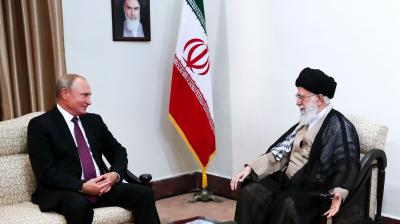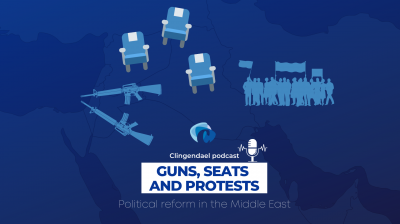Iran’s 2022 anti-government protests shook the country and reverberated across the world. As videos went viral of young men and women protesting en masse and of the evermore brutal crackdown by security forces, one thing became clear: Something fundamental has changed in Iran. To navigate through the latest news and place the happenings in a broader perspective, we have created a compilation of our latest articles, videos and 'in the media' expert comments.
Publications
New blog series 'Iran in transition'
Clingendael and guest experts track different dimensions of the evolution of protests and governance in Iran.
#1: Lost in transition: Where might Iran be heading?
The 2022 protests reflect decades of accumulated social and political grievances. Iran has witnessed big protest movements before, such as those of 2009 and 2019. Yet, this has been the first time that the call to overthrow the Islamic Republic has become the public’s main demand. More importantly, it united Iranians across economic classes, geographical locations, and ethnic groups. The protests can be viewed as the starting shot of a transitional process for Iranian society and politics.
#2: East of Eden: Will Tehran find salvation in 'looking Eastwards'?
There is a paradox at the heart of Iran’s foreign relations. On the one hand, Tehran appears to feel more confident than ever due to its recent achievement of a number of foreign policy milestones. These include a strategic upgrade of its relationship with Russia, closer ties with China, a newly minted understanding with Saudi Arabia and the absence of consequences for keeping the nuclear negotiations in a dead end. On the other hand, these headline successes obscure significant longer-term economic and geopolitical risks.
#3: Dark comedy or strategy: the dire straits of Iran's economy
Iran is currently experiencing its deepest and longest economic crisis in its modern history. Root causes are multipal failings of its political system. From an economic perspective, two issues are paramount. 𝐅𝐢𝐫𝐬𝐭, the ideological and geopolitical objectives of Iran’s ruling elites generate external pressures, such as tense regional relations and international sanctions, that reduce economic prospects and decrease social welfare. 𝐒𝐞𝐜𝐨𝐧𝐝, Iran has levels of corruption that impose deadweight losses on its economic prosperity. Corruption reduces the private sector dynamics and hinders the growth of social capital. With these root causes in mind, Mahdi Ghodsi outlines four effects of Iran’s poor economic policies in what follows, and relate these to the present situation of persistent social unrest.
#4: Unveiling resistance: The struggle for women's rights in Iran
The sweeping public protests that erupted across Iran in response to the death of Mahsa (Jina) Amini in custody of Iran’s morality police last September have been characterized by many observers as the first feminist uprising in the region. The visually powerful images of women and girls defying compulsory hijab laws in the streets and the slogan “women, life, freedom” have strengthened this characterization and drawn broad international sympathy. But the sweeping protests and their demands for fundamental change were met with a brutal government crackdown that resulted in hundreds of deaths and tens of thousands of arbitrary arrests. Almost nine months later, women’s right to choose their own way of dressing remains at the center of the protest movement. Understanding why requires a closer look at how the broader struggle of women for equal rights in Iran has evolved over the years.
#5: Fifty shades of hardliners: Intra-elite dynamics in Iran
This blog examines how relations among Iran’s political elites have evolved in the social, economic and foreign policy areas. The blog also discusses implications of shifts in elite relations for the broader process of transition in Iran.
#6: Iran’s transition six months on: Repression meets resilience
Our blog series explores power dynamics in four critical dimensions that shape the country’s direction: state-society relations, intra-elite dynamics, the economy, and foreign relations. This particular blog post analyzes key dynamics in these fields between March to September 2023, and seeks to decipher what they tell us about the direction of change in Iran.
#7: Opposition politics of the Iranian diaspora: Out of many, one - but not just yet
Our blog series explores power dynamics in four critical dimensions that shape the country’s direction: state-society relations, intra-elite dynamics, the economy, and foreign relations. This particular blog post analyzes key dynamics in these fields between March to September 2023, and seeks to decipher what they tell us about the direction of change in Iran.
Report
Protests in Iran in comparative perspective
Successive protests in 2009, 2019 and 2022 have poignantly laid bare the much reduced social and political legitimacy of Iran’s ruling elites. Reform-from-within is no longer viewed as credible. While further protests are inevitable, it is nevertheless unlikely that they will produce a revolution that overthrows the regime in the short-term, as long as their national organisation and leadership remain weak, Iran’s ruling elites cohesive, security forces loyal, and the administration continues to function.
Subscribe to our Middle East Updates.







